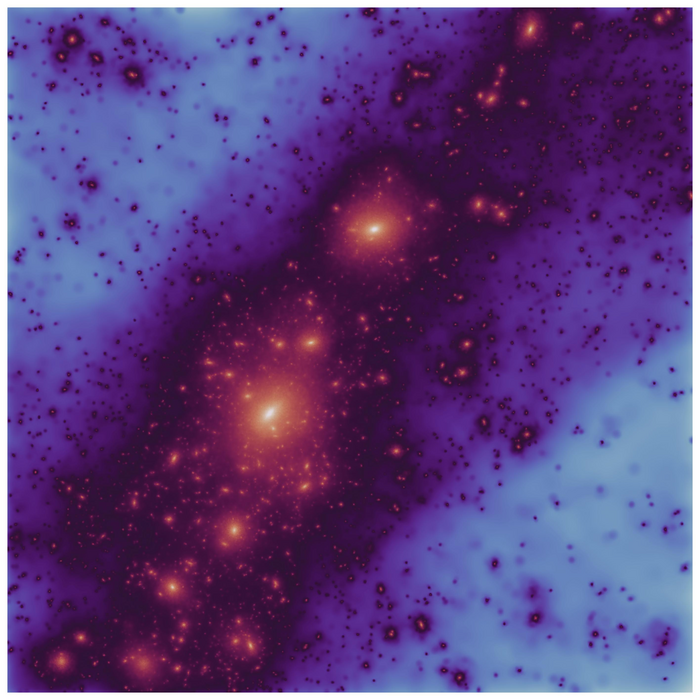Astronomers claim to have solved a long-standing mystery about how the Universe evolved: the spatial distribution of faint satellite galaxies around the Milky Way.

One of the new high-resolution simulations of the dark matter enveloping the Milky Way and its neighbor, the Andromeda galaxy. The new study shows that earlier, failed attempts to find counterparts of the plane of satellites which surrounds the Milky Way in dark matter simulations was due to a lack of resolution. Image Credit: Till Sawala/Sibelius collaboration
These satellite galaxies have an unusual alignment in which they appear to reside on an immense, thin, rotating plane known as the “plane of satellites.”
For more than 50 years, astronomers have been perplexed by this seemingly improbable arrangement, causing many to question the validity of the mainstream cosmological model, which aims to reveal how the Universe came to look the way it does today.
Now, a new study collaboratively headed by the Universities of Durham, UK, and Helsinki, Finland, has discovered that the plane of satellites is a cosmological quirk that will disappear with time in the same way that star constellations gradually alter.
Their findings eliminate the threat presented by the plane of satellites to the mainstream model of cosmology.
This concept describes how the Universe started and how the galaxies witnessed today grew gradually among clumps of cold dark matter—a mysterious substance that accounts for around 27% of the Universe.
The findings were published in Nature Astronomy.
The satellites of the Milky Way appear to be grouped in an implausibly thin plane piercing through the galaxy, as well as circling in a coherent and long-lived disk.
There is no known physical mechanism capable of transforming satellite planes. Instead, satellite galaxies were expected to be grouped in a nearly circular configuration, tracing the dark matter.
Since the discovery of satellite planes in the 1970s, astronomers have sought and failed to locate similar structures in realistic supercomputer simulations of the Universe’s evolution from the Big Bang to the present day.
The inability to explain the satellite arrangement led academics to believe that the cold dark matter theory of galaxy formation was incorrect.
However, astronomers used new data from the European Space Agency’s GAIA space observatory in this current study. GAIA is creating a six-dimensional map of the galaxy, including exact locations and velocity measurements for around one billion stars (about 1% of the total) and their companion systems.
Scientists were able to project the satellite galaxies’ orbits into the past and future and witness the plane form and dissipate in a few hundred million years—a mere blink of an eye in cosmic time.
The researchers also looked for indications of planes of satellites in fresh, custom-made cosmological models.
They understood that earlier simulation-based analyses had been misled by not accounting for the distances of satellites from the center of the galaxy, which had caused the virtual satellite systems to appear considerably rounder than the actual ones.
Taking this into consideration, scientists discovered numerous virtual Milky Ways, each with a plane of satellite galaxies similar to the one visible through telescopes.
This, according to the researchers, eliminates one of the primary challenges to the validity of the standard model of cosmology and confirms that the idea of dark matter continues to be fundamental to the understanding of the Universe.
The strange alignment of the Milky Way's satellite galaxies in the sky had perplexed astronomers for decades, so much so that it was deemed to pose a profound challenge to cosmological orthodoxy. But thanks to the amazing data from the GAIA satellite and the laws of Physics, we now know that the plane is just a chance alignment, a matter of being in the right place at the right time, just as the constellations of stars in the sky.
Carlos Frenk, Study Co-Author and Ogden Professor, Fundamental Physics, Institute for Computational Cosmology, Durham University
Carlos Frenk adds, “Come back in a billion years, and the plane will have disintegrated, as will today's constellations. We have been able to remove one of the main outstanding challenges to the cold dark matter theory. It continues to provide a remarkably faithful description of the evolution of our Universe.”
The plane of satellites was truly mind boggling. It is perhaps unsurprising that a puzzle which has endured for almost fifty years required a combination of methods to solve it - and an international team to come together.
Dr Till Sawala, Study Lead Author, University of Helsinki
The study was financially supported by the European Research Council, and the UK Science and Technology Facilities Council and made extensive use of the Cosmology Machine (COSMA) supercomputer at Durham University. COSMA is hosted by Durham as part of the Science and Technology Facilities Council-funded DiRAC High-Performance Computing facility to support researchers across the United Kingdom.
Journal Reference
Sawala, T., et al. (2022) The Milky Way’s plane of satellites is consistent with ΛCDM. Nature Astronomy. doi.org/10.1038/s41550-022-01856-z.